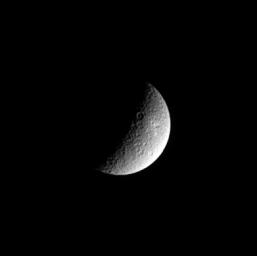
|
Rhea’s Ancient Surface
- Click the image above for a larger view
- Full-Res JPEG (391 x 390) (4.3 kB)
- Full-Res TIFF (391 x 390) (26.6 kB)
Caption:
The sunlight angle in this sharp view of Saturn's second-largest moon, Rhea, highlights the moon's crater-strewn surface. Cassini will fly past Rhea on Nov. 26, 2005, at a distance of only 500 kilometers (311 miles) and will obtain very high resolution images at that time. Rhea's diameter is 1,528 kilometers (949 miles).
This view shows mainly the hemisphere of Rhea that faces away from Saturn. The image was taken in visible light with the Cassini spacecraft narrow angle camera on Nov. 1, 2004, at a distance of 1.6 million kilometers (994,000 miles) from Rhea and at a Sun-Rhea-spacecraft, or phase, angle of 102 degrees. North is up. The image scale is about 10 kilometers (6 miles) per pixel. The image has been slightly contrast enhanced to aid visibility of surface features.
Background Info:
The Cassini-Huygens mission is a cooperative project of NASA, the European Space Agency and the Italian Space Agency. The Jet Propulsion Laboratory, a division of the California Institute of Technology in Pasadena, manages the mission for NASA's Science Mission Directorate, Washington, D.C. The Cassini orbiter and its two onboard cameras were designed, developed and assembled at JPL. The imaging team is based at the Space Science Institute, Boulder, Colo.
For more information, about the Cassini-Huygens mission visit, http://saturn.jpl.nasa.gov and the Cassini imaging team home page, http://ciclops.org .
Cataloging Keywords:
| Name | Value | Additional Values |
|---|---|---|
| Target | Rhea | Saturn |
| System | Saturn | |
| Target Type | Satellite | Planet |
| Mission | Cassini-Huygens | |
| Instrument Host | Cassini Orbiter | |
| Host Type | Orbiter | |
| Instrument | Imaging Science Subsystem (ISS) | |
| Detector | Narrow Angle Camera | |
| Extra Keywords | Crater, Grayscale, Visual | |
| Acquisition Date | ||
| Release Date | 2005-01-06 | |
| Date in Caption | 2004-11-01 | 2005-11-26 |
| Image Credit | NASA/JPL/Space Science Institute | |
| Source | photojournal.jpl.nasa.gov/catalog/PIA06555 | |
| Identifier | PIA06555 | |
